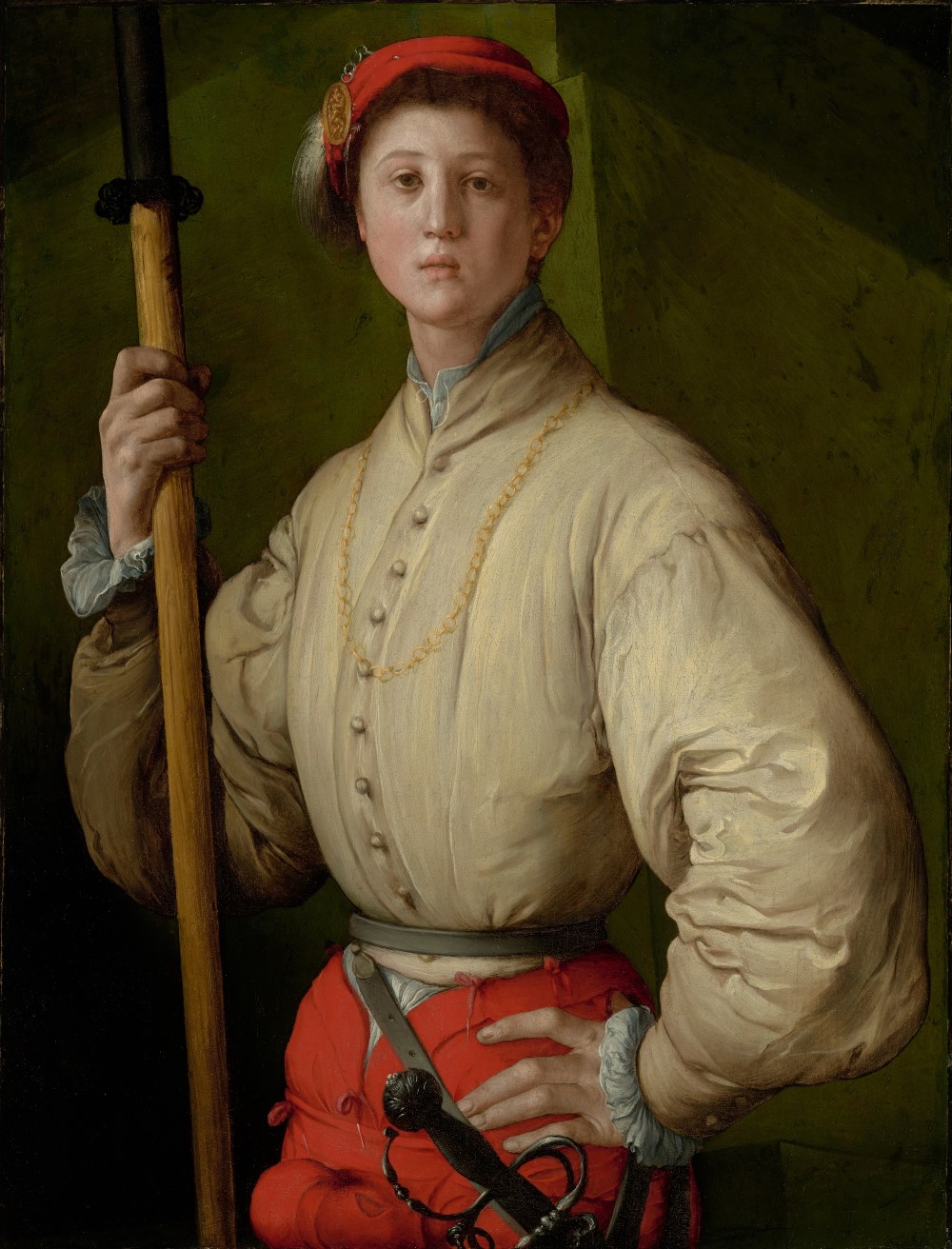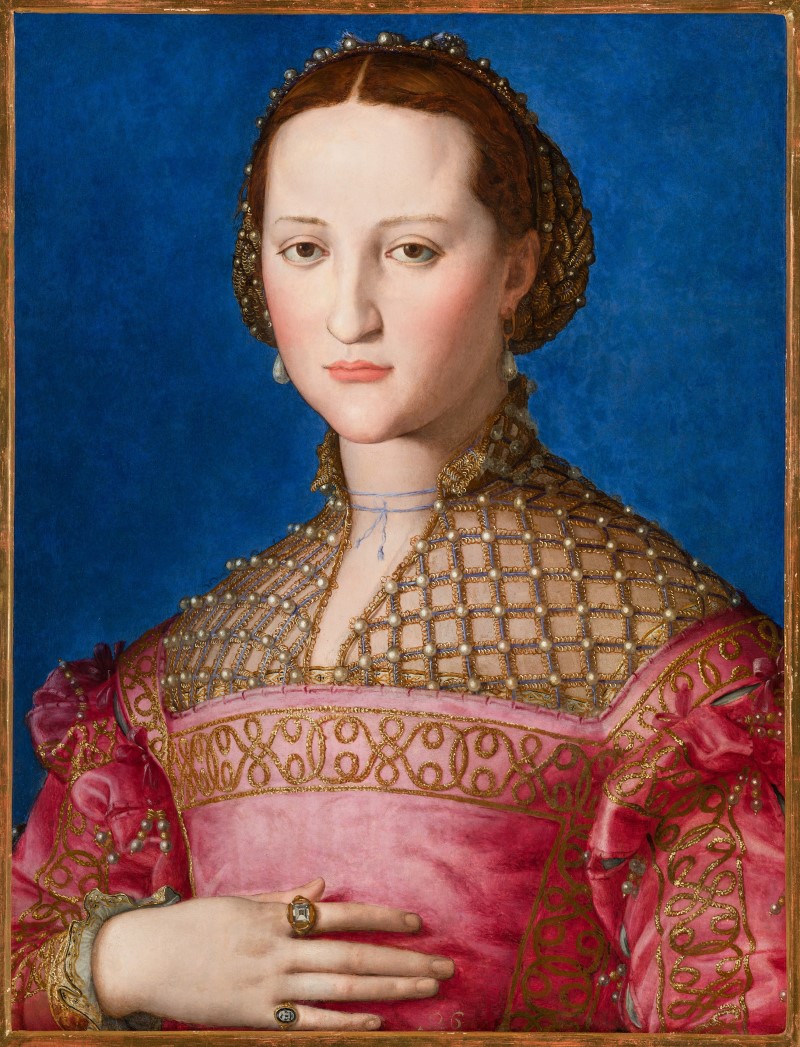
“The Medici: Portraits and Politics 1512-1570,” which opened at The Metropolitan Museum of Art on June 26, is the kind of show most other U.S. museums can only dream of attempting. If you’re looking to see a big, beautiful art exhibition this summer, this is definitely the one you don’t want to miss.
Yet make sure that, if you do go, you don’t get too caught up in the flash and glam of what you see. There’s a lot more going on behind the careful poses and stylish outfits than what might at first appear.
You’ll remember from world history class that during the 15th century, the Medici rose from relative obscurity to become the de facto rulers of the Florentine Republic. Thanks to a fortune made as moneylenders to popes and princes, they were able to buy support—along with the muscle to enforce it—in the often violent, bloody field of Italian Renaissance politics. With power and means, they became great patrons of the arts and sciences, while consolidating their grip over Tuscany and threatening nearby states.
By the 16th century, the Medici had been exiled, replaced by a theocracy, returned under a restored republic, and exiled again, until they were finally established as the rulers of Tuscany, thanks to support from the Holy Roman Empire and the papacy. Now no longer simply glorified loan sharks employing mercenary thugs, they wanted to make the most of their new social status.
What better way to show that they had finally arrived and that the republic was long gone than by commissioning splendid works of art depicting themselves and those who paid court to them?
It’s easy to be dazzled by the objects in this show. At the entrance, a monumental, well more than life-sized bronze bust of Grand Duke Cosimo I de’ Medici (1519-1574), made around 1546-47 by Benvenuto Cellini (1500-1571), sports armor worthy of a Roman emperor, while the duke’s newly restored eye whites gleam with silver leaf. The entire thing was originally gilded, because of course it was.
In the paintings, armor and jewels glisten, as does the clothing, such as in the circa 1551 portrait of the grand duke’s eldest son and successor, young Francesco de’ Medici (1541-1587), by Agnolo Bronzino (1503-1572). This is one of those instances where the difference between seeing a photograph of a work of art and seeing the real thing is quite profound. In person, Bronzino’s use of impasto to depict the boy’s purple tunic and its gold embroidery quite visibly sparkles, an effect no camera can hope to capture.

Similar evocations of texture and careful attention to detail appear throughout the exhibition. Furs and velvets invite us to feel their plush texture, while silks seem to change color depending where one stands. Realistic tassels hang heavily from sleeves and the corners of pillows. There are dogs (and codpieces) of various sizes, as well as elegantly elongated hands, slender necks, and languid limbs.
The famous “Portrait of a Halberdier” (c. 1529-1530) by Jacopo Pontormo (1494-1557) is here, on loan from the Getty in Los Angeles. For decades, it was the most expensive Old Master painting ever sold at auction, prior to Leonardo da Vinci’s “Salvador Mundi.”

Next to the Getty portrait is a case containing a halberd from the Medici court, alongside a cabinet featuring a group of beautiful but deadly weapons of the period. Since these, and indeed all of the objects in the show, are displayed against walls painted in rich reds, blues, and greens, the overall effect on the senses is powerful.
For example, there’s a jewel-like portrait of the Spanish aristocrat Eleanora de Toledo (1522-1562), the first wife of Cosimo I. It was painted about 1539-40 by Bronzino, and is on loan to the exhibition from the National Gallery of Prague.
The newly married duchess, in the first of many portraits her husband commissioned of her during their happy marriage, is depicted against an intense blue background, surrounded by a carved and gilded frame that is a work of art in itself. This, in turn, hangs on an intensely blue wall, overwhelming the eye with visual stimuli.

Modern eyes may find the people shown in many of these portraits rather difficult to read. Facial expressions generally occupy a narrow range between haughty and reserved to intensely focused and self-confident. Since it’s commonly believed that the Medici court was one largely of show and pretense, what we see in these galleries may seem at first to be little more than a collection of ciphers.
Perhaps the issue here is of expectation versus intention. We can become so caught up in the showiness of this exhibition, expecting to be fascinated by the glamour of those appearing in it, that we can easily lose sight of other elements that were just as important to these people five centuries ago as they are to us today. One example: the clear importance the Medici court placed on literacy and the use of language as a means to exert political and social power.
With Italy’s early and enthusiastic adoption of the printing press, not only was the ability to read and write becoming possible for more and more people, it became increasingly important to reach the upper levels of society. Conversations over dinner might effortlessly turn from recitations of poetry to discussions of political theory or philosophy. As explained in superb detail in the exhibition’s catalog, as the power of Latin as a universal language began to wane, and the use of vernacular languages in European courts became more important, the Medici tried to straddle the divide.
As a result, Latin remained critical for success in the Medici orbit, thanks to the family’s close association with the papacy. The Medici, after all, produced four popes. Yet they also accepted and encouraged writing in the Tuscan form of Italian, partly as a way to exert greater control over their contemporaries and to solidify their grip over their territories.
Bearing this in mind, it’s worth noting that, among the more than 90 objects in this show, I counted 23 examples of what we might call literacy-signaling, not including a selection of period books and documents in the exhibition. In these paintings and drawings, sometimes a book is held open in one hand, or a finger is inserted into a particular spot, as if the individual has just paused in his or her reading.
In other instances, a book, letter, or other document is being carried, or a piece of writing may sit on a table nearby. Having a book or a document figure prominently in their portrait was, for many of these sitters, just as important as being well-dressed.
In their portraits, military men from the Medici court could get away with simply holding a weapon while dressed in armor. Yet the prominent display of literary devices in these portraits shows the Medici were concerned with promoting the image of Florence under their absolute rule as a kind of modern-day Parnassus.
Indeed, the exhibition even includes Medici nudes portrayed as Greco-Roman gods. The Medici clearly wanted it to be known that great talents and thinkers were welcome in Tuscany, and would find a place to discuss their ideas with a ruling class who could both understand and patronize their work. This profound desire of the Medici court to surround itself with the leading intellectual lights of the day didn’t always succeed, however.
Possibly the most famous (or infamous) example of this was the ongoing effort of Cosimo I to persuade Michelangelo (1475-1564) to return to Florence from Rome. It never happened, but that didn’t stop Cosimo from having Michelangelo’s body stolen from Rome after he died, in order to be brought back to Florence and buried with the equivalent of a state funeral that went on for days. A striking, unfinished portrait of the master sculptor, painter, architect, poet, and man of letters, currently attributed to Daniele da Volterra (1509-1566), appears in the exhibition.

There’s certainly no glamour in this picture, and it provides a sharp contrast to the fashionable men and women whose portraits hang nearby. Politically speaking, this should come as no surprise. Michelangelo lamented the overthrow of the Florentine Republic and the reestablishment of Medici domination, although at various times he benefitted greatly from the family’s patronage.
This generation of the family’s conspicuous consumption, in contrast to the more subdued Medici bankers of the preceding century, allowed them to draw others in, solidify their position, and promote their absolute rule. Perhaps the takeaway is that in politics, as in art, it’s best not to let yourself get so distracted by the show that you miss what’s really going on.
“The Medici: Portraits and Politics 1512-1570” is at The Metropolitan Museum of Art in New York through October 21. As of this writing, tickets are on timed entry only, due to lockdowns. Please visit here for more information.









